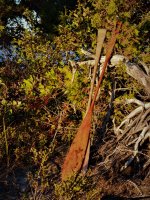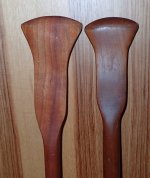hmm. I have a Loon Works Duet. I can't kneel . The poor thing just sits in the garage. Its 46 lbs as it is cecconite covered not canvas 15 feet.That's encouraging. I know the butternut won't have the flex of cherry. I dream of using my new ottertail in a wood-canvas canoe, but I don't own one anymore. So I further dream of buying a lightweight one.
-
Happy "Killer Rabbit" Attacks President Carter in His Paddle Boat (1979)! 🚣🏼♂️🐇
You are using an out of date browser. It may not display this or other websites correctly.
You should upgrade or use an alternative browser.
You should upgrade or use an alternative browser.
My quest for the best custom made ottertail paddle in the world
- Thread starter Glenn MacGrady
- Start date
I've been loving my ottertail for decades! while it doesn't move a ton of water compared to the sugar island style, and is poor in shallow waters, it does allow a fast, easy cadence on deeper, flat waters, and puts far less strain on my shoulders and back than more conventional paddles.
Now if only I could find a bow paddler that can keep up to the faster cadence....
Now if only I could find a bow paddler that can keep up to the faster cadence....
But the bow paddler sets the cadence; the stern person can gently suggest adjustments. Easier to paddle that way.. Bow paddlers can't see your cadence ; the rumour that we have eyes in the back of our heads isn't true.I've been loving my ottertail for decades! while it doesn't move a ton of water compared to the sugar island style, and is poor in shallow waters, it does allow a fast, easy cadence on deeper, flat waters, and puts far less strain on my shoulders and back than more conventional paddles.
Now if only I could find a bow paddler that can keep up to the faster cadence....
What is your preferred cadence? I've been a primary bow paddler for more than 25 years now, with nigh on to nearly 10,000 accumulated miles in the seat between that many years of training for and in marathon length races, plus recreational paddling. My all-day race cadence tends to average around 60spm, easily higher with sprints into the 80s as needed or simply when bored. Of course somwhat less when recreational paddling as appropriate.Now if only I could find a bow paddler that can keep up to the faster cadence....
I got my Bruce Smith 58" butternut ottertail with black walnut laminations on the shaft and grip two weeks ago. It weighs 22 oz., two ounces of which are probably due to the black walnut. I haven't used it yet, other than admiring and fondling. It's a work of art with a high grade furniture finish. I'll take pictures when my back allows me to go out for the paddle's first voyage.
Hope your back unfreezes before the water freezes.
@Glenn MacGrady and others who have Bruce Smith paddles - how's the edge thickness on the blade?
I have a couple Badger paddles and love the fine edge and narrower shaft. While not as strong, they're lighter and have a lot more flex than the Fishell paddle I have, which I like much more (all are solid cherry). The Fishell has a much thicker shaft and blade, so while better in rock territory, it's a bit of a beast (33oz vs 25oz on the Badgers) and I much prefer the Badgers for deep water cruising these days.
I have a couple Badger paddles and love the fine edge and narrower shaft. While not as strong, they're lighter and have a lot more flex than the Fishell paddle I have, which I like much more (all are solid cherry). The Fishell has a much thicker shaft and blade, so while better in rock territory, it's a bit of a beast (33oz vs 25oz on the Badgers) and I much prefer the Badgers for deep water cruising these days.
My Fishell Ray Special just arrived this past week, and beyond checking it over for mishandling in transit, that’s the last I get to see of it til Christmas  it sure is pretty, all curly cherry. Surprisingly light, though I haven’t weighed it.
it sure is pretty, all curly cherry. Surprisingly light, though I haven’t weighed it.
Those look nice, did you make them?
@Abenakiregion
A big fan of maple Northwoods paddles. Really good flex.
View attachment 127247
Those look nice, did you make them?
Last edited:
- Joined
- Nov 22, 2021
- Messages
- 313
- Reaction score
- 177
I recently ordered two ottertails from Fishell. I think they are called the modified special and the modified ottertail. The price was pretty reasonable, especially for the second one which I got at 20% off. I liked the fact that it had a wide shoulder close to the lower hand. I had, in fact, thought about making my own paddle with this sort of design, before finding FishellBeing seduced in my dotage by certain possible hydrodynamic advantages of the ottertail blade shape for canoe cruising, but never having owned one amongst my dozens of paddles, I embarked on a quest in April to find the best custom paddle maker in North America.
With some candidates in mind, I learned that the first challenge was to actually get in touch with one of these small or one man shops. Or, if I could get in touch, to get any sort of firm commitment on a manufacture and ship date. Some of these folks had an annoying habit of being unavailable because they had the temerity to simply disappear . . . to . . . go . . . canoeing! How dare they!?
I finally settled on the fully hand-crafted paddles of the venerable Bruce Smith, who has been making custom paddles and wood-canvas canoes in the Fergus, Ontario, area since the 1970's, having been taught by the legendary Walter Walker, whose canoes can still fetch prices of over $20,000. Bruce's paddles feature his trademark version of a secondary grip, sometimes called a "running pry grip" in Canada or a "northwoods" or "guide" grip in Maine.
View attachment 127020
I didn't want a heavy and especially a blade heavy animal tail "club", as some of my beavertails are, and had many emails and a phone call with Bruce about a lightweight wood choice with optimal shaft-blade balance. We settled on butternut, which is an increasingly rare wood in Canada because of a fungus killing live butternut trees en masse and powder puff beetles boring holes in the dead trees. But Bruce did have a nice butternut board for a 58" paddle with a pronounced plain sawn grain pattern, shown here next to a 57" blem butternut paddle:
View attachment 127021
View attachment 127025
Because Butternut has a fairly low Janka hardness and modulus of rupture -- i.e., is somewhat soft, breakable and subject to denting -- Bruce recommended laminating the shaft with a cousin wood, edge grain black walnut, to increase shaft strength and reduce denting, as used in the blem paddle shown above. I liked this idea for aesthetic reasons also, and further requested a matching black walnut inlay in the top grip.
Having settled all that over three months, Bruce of course went . . . canoeing.
However, he did make 21 custom paddles in August and just sent a picture of them all. Naturally, I already think mine is the most aesthetic. (Can you spot it?)
View attachment 127023
Here is Bruce's description of what is going on with the paddle in the small bucket on the extreme right:
"If you look closely, you will see that I am soaking the tip of my black cherry modified Ottertail on the right. I am using about 80% boiled linseed oil mixed with 20% varsol or mineral spirits. The latter helps the oil penetrate better....deep into the cells. This routine about every 3 years for 4 or 5 days gives you a permanent water seal in the wood fibre at the tip. This keeps water out and prevents the wet/dry or expansion/contraction cycle that often leads to cracks at the tip. An old timer taught me this when I worked at the Ontario Camp Leadership in 1972.......been using this trick ever since."
"I have 4 soaker coats on today with about 50% varsol, 2 more tomorrow and one a day until Sunday. The walnut and butternut ones along with the maple ones will be given 4 coats of spar varnish."
So, I am now awaiting some sort of shipment and figuring out how to pay for it, but naturally Bruce also reports: "I will be leaving for Temagami next Tuesday evening so I would like to get them out on Monday or Tuesday at the latest." Oy vey!
When I finally get my long-awaited paddle, hopefully for some fall paddling, I'll take some close-up photos and report on the actual hydrodynamics.
You can watch video bio of Bruce Smith and his paddle making shop on this page:
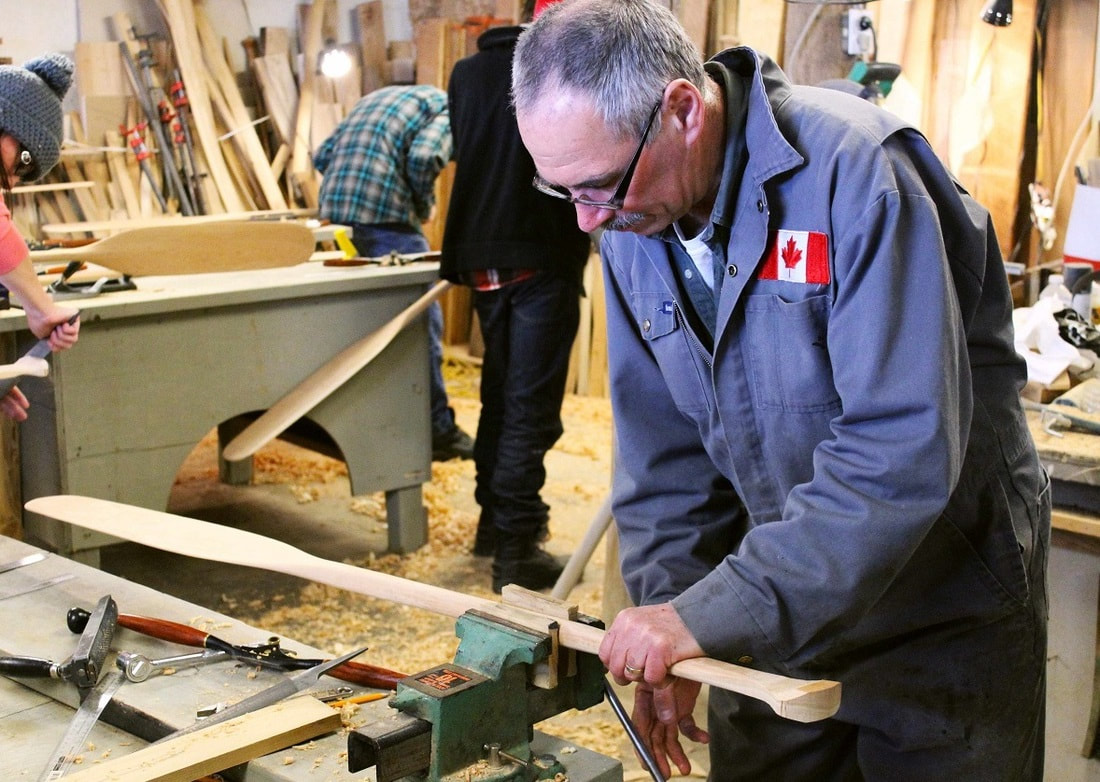
Bruce Smith Paddles Bio
Bruce Smith had over 50 years experience as a master level canoeist and expert wood worker. He now teaches paddle making workshops and sells his paddle creations in Fergus, Ontariowww.brucesmithpaddles.com
I'll let you know what I think about them, next summer.
You have a nice looking paddle. I'll have to take a look at Bruce's website.
Yes, the darker stern paddle is curly maple and the bow paddle is bird'seye maple. The photo doesn't do the grain justice.Those look nice, did you make them?
So, it's time to evaluate my Bruce Smith butternut ottertail, which has black walnut laminations on the shaft and grip, and to show some pictures.
The paddle is 58" long and weighs 22 oz. It's a work of art. I don't have a tool to measure blade thickness, but it's as thin as any of my cedar and other softwood paddles. It's not as thin, of course, as a carbon paddle. Although butternut is a hardwood, it's one of the lightest and hence one of the softest and most breakable of the hardwoods. For that reason, a butternut paddle has to be made slightly thicker than an ash, cherry or maple paddle. But it will still weigh less.
The paddle has little flex. Cherry and sassafras paddles can be made with much more flex. But I don't like a lot of flex and was mostly after light weight and a popping wood grain.
How does it perform? Well, I've used a lot of different paddles in 69 years of canoeing, but this was my first ottertail. My initial impression was that it has a softer pull through the water than any of my sugar island, honey island, beavertail, magnum, or teardrop-racing blade shapes, whether bent or straight shafted. On the other hand, it provides a little less corrective force using a J stroke, C stroke, pitch stroke, or Canadian (knifing J) stroke than my other straight paddle blade shapes. Hence, I have to hold corrections a tad longer or stronger, as I have to do with bent shaft paddles.
I got used to all this after about an hour, and found myself mostly using either a palm-rolled, fully-inwater return Indian stroke or else a Canadian stroke levered off the gunwale. Using the gunwale lever technique, which is akin to the Northwoods stroke, allowed me to make the best use of Bruce Smith's trademark running pry secondary grip—that is, holding my grip hand horizontally on the flat shaft underneath the top grip.
All in all, the hydrodynamic feel is not dramatically different from a sugar island blade shape—just, as I've said, a little softer on the pull and requiring some greater technique attention to the correction. I didn't try any under-hull strokes with a radical heel, which is a performance area where the ottertail shape should excel. It's not a paddle for racing or hard whitewater moves, but hits the sweet spot for all day cruising. On an extended trip, I'd probably pair it with one of my carbon bent shaft paddles.
Paddling, to me, is all about aesthetics—tactile aesthetics, visual aesthetics, auditory aesthetics, neural aesthetics, and muscle-feel aesthetics. For all that, the Bruce Smith butternut ottertail is one heckuva aesthetic paddle!
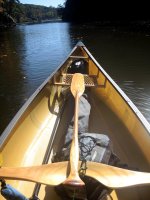
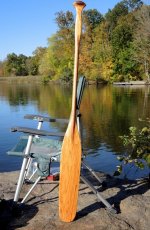
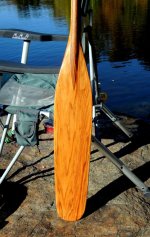
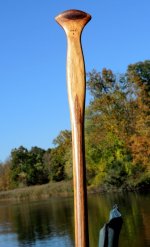
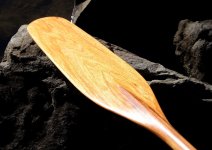
The paddle is 58" long and weighs 22 oz. It's a work of art. I don't have a tool to measure blade thickness, but it's as thin as any of my cedar and other softwood paddles. It's not as thin, of course, as a carbon paddle. Although butternut is a hardwood, it's one of the lightest and hence one of the softest and most breakable of the hardwoods. For that reason, a butternut paddle has to be made slightly thicker than an ash, cherry or maple paddle. But it will still weigh less.
The paddle has little flex. Cherry and sassafras paddles can be made with much more flex. But I don't like a lot of flex and was mostly after light weight and a popping wood grain.
How does it perform? Well, I've used a lot of different paddles in 69 years of canoeing, but this was my first ottertail. My initial impression was that it has a softer pull through the water than any of my sugar island, honey island, beavertail, magnum, or teardrop-racing blade shapes, whether bent or straight shafted. On the other hand, it provides a little less corrective force using a J stroke, C stroke, pitch stroke, or Canadian (knifing J) stroke than my other straight paddle blade shapes. Hence, I have to hold corrections a tad longer or stronger, as I have to do with bent shaft paddles.
I got used to all this after about an hour, and found myself mostly using either a palm-rolled, fully-inwater return Indian stroke or else a Canadian stroke levered off the gunwale. Using the gunwale lever technique, which is akin to the Northwoods stroke, allowed me to make the best use of Bruce Smith's trademark running pry secondary grip—that is, holding my grip hand horizontally on the flat shaft underneath the top grip.
All in all, the hydrodynamic feel is not dramatically different from a sugar island blade shape—just, as I've said, a little softer on the pull and requiring some greater technique attention to the correction. I didn't try any under-hull strokes with a radical heel, which is a performance area where the ottertail shape should excel. It's not a paddle for racing or hard whitewater moves, but hits the sweet spot for all day cruising. On an extended trip, I'd probably pair it with one of my carbon bent shaft paddles.
Paddling, to me, is all about aesthetics—tactile aesthetics, visual aesthetics, auditory aesthetics, neural aesthetics, and muscle-feel aesthetics. For all that, the Bruce Smith butternut ottertail is one heckuva aesthetic paddle!





Some more pictures of my butternut Bruce Smith ottertail before launching.
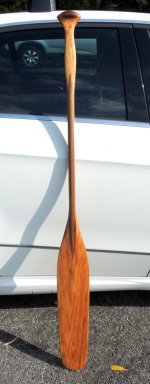
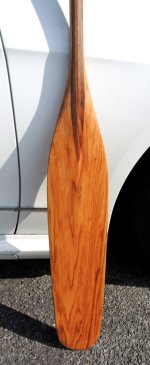
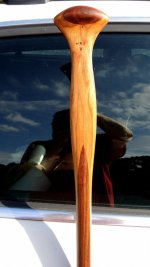
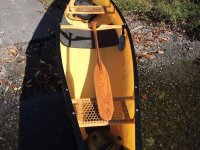
This last picture of the paddle distorts the blade shape because of lens foreshortening, but shows off the other side wood grain and the Nova Craft Bob Special aramid canoe.
In the very bottom end of the canoe, you can see a 20 liter dry bag with ~40 pounds of water ballast, annoyingly needed when paddling backwards from the bow seat.




This last picture of the paddle distorts the blade shape because of lens foreshortening, but shows off the other side wood grain and the Nova Craft Bob Special aramid canoe.
In the very bottom end of the canoe, you can see a 20 liter dry bag with ~40 pounds of water ballast, annoyingly needed when paddling backwards from the bow seat.
Last edited:
Really gorgeous paddle.
Bob
Bob
Glenn, do you what finish Bruce uses? I love the warm glow of the wood. Never liked the “wet look” on wood, I’ve always preferred a satin or hand-rubbed finish.
I suppose he would do whatever is requested. Every paddle is custom made by hand. He's a one man shop, not a factory, so he'll discuss every detail of the paddle you want built including the finish.
I seem to recall that his standard recommended finish depends on the wood: that most woods are hand rubbed with an oil blend, while the softer woods such as butternut, walnut and maple get four coats of spar varnish for protective reasons. My butternut paddle was varnished, which was his recommendation that I accepted.
Some paddlers like their blades varnished and shafts/grips oiled.
I know some builders will use a satin finish on their last coat of varnish only to knock down the shine.
Bob
Bob
Similar threads
- Replies
- 37
- Views
- 4K
- Replies
- 24
- Views
- 2K
- Replies
- 6
- Views
- 603

